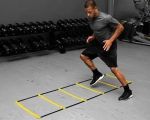How to Set Up a Fitness Routine for Beginners
When I first decided to start working out, I was intimidated. I had no idea where to begin, what exercises to do, or even how to stay motivated. The overwhelming amount of fitness advice on the internet didn’t help either. But over time, I learned the key to setting up a fitness routine that works, especially for beginners like me. It’s all about starting slow, staying consistent, and gradually pushing yourself to improve. In this article, I’ll share the step-by-step process I used to create a fitness routine that helped me build healthy habits and achieve my goals.
If you're new to exercise or looking to get back into a fitness routine after a break, it’s important to start with the basics. The goal is not to jump straight into intense workouts but to build a foundation that sets you up for success. Let's walk through the steps I followed and how you can apply them to your own fitness journey.
1. Set Realistic Fitness Goals
Before starting my fitness journey, I made the mistake of setting unrealistic goals, like losing 20 pounds in a month or running a marathon in a few weeks. I quickly realized that these goals were not only unrealistic but also discouraging when I couldn’t achieve them. Setting realistic and achievable goals is the first step to creating a sustainable fitness routine.
To set your goals, I recommend using the SMART method, which stands for Specific, Measurable, Achievable, Relevant, and Time-bound. For example, instead of aiming to "get fit," set a goal like, "I want to be able to walk for 30 minutes without feeling winded in 4 weeks." This goal is specific, measurable, and achievable. Over time, you can gradually increase the intensity of your goals as your fitness improves.
2. Start with Simple Exercises
When I started, I didn’t have any previous experience with exercise, so jumping straight into complex movements felt intimidating. Instead, I focused on basic exercises that were easy to learn but still effective. Walking, bodyweight exercises like squats, lunges, and push-ups, and simple cardio exercises like cycling or swimming helped me build a solid foundation.
As a beginner, focusing on bodyweight exercises is a great way to build strength without needing any equipment. I also started incorporating yoga and stretching into my routine to improve flexibility and prevent injury. I recommend starting with 2-3 days a week of these exercises and gradually increasing the frequency as you feel more comfortable.
3. Mix Up Your Routine
One thing I learned early on is that variety is key to staying engaged and preventing boredom. It’s easy to fall into a rut if you do the same exercises over and over. That’s why I made sure to mix up my routine to target different muscle groups and keep things interesting.
For example, I started with a basic workout that included walking on the treadmill, doing squats and lunges, and cycling. As I became more confident, I added in strength training exercises with dumbbells, HIIT (High-Intensity Interval Training) workouts, and outdoor activities like hiking or biking. By diversifying my routine, I kept myself motivated and challenged. You can do the same by trying new activities like swimming, dancing, or joining a fitness class. It’ll help prevent plateaus and keep things exciting!
4. Gradually Increase Intensity
At first, I was tempted to push myself as hard as possible, but I quickly realized that overexerting myself led to burnout and sore muscles. It’s important to listen to your body and gradually increase the intensity of your workouts. As a beginner, focus on building endurance and strength before moving on to more advanced exercises.
Start with lower-impact exercises and focus on improving your stamina and form. For example, if you’re walking for cardio, start with 15-minute sessions and gradually work your way up to 30 minutes or longer. Similarly, with strength training, focus on mastering basic movements before adding more weight or resistance. Over time, your body will adapt, and you’ll be able to handle more challenging workouts without risking injury.
5. Schedule Your Workouts
One of the biggest mistakes I made at the beginning was not scheduling my workouts. I thought I could just fit them in whenever I had time, but that often meant I skipped workouts or didn’t stay consistent. To make exercise a habit, I had to treat it like any other important appointment and schedule it into my day.
I recommend planning your workouts for the week ahead. Pick specific days and times that work with your schedule, and make them non-negotiable. I also suggest finding a workout buddy or joining a fitness community to help keep you accountable. For me, having a set routine made it easier to stick to my fitness goals, and over time, working out became a natural part of my lifestyle.
6. Focus on Recovery and Rest
When I first started working out, I was so focused on exercising that I didn’t give enough attention to rest and recovery. But I quickly learned that rest is just as important as the workouts themselves. Your muscles need time to recover and repair in order to grow stronger.
Rest days are crucial for beginners to prevent injury and allow the body to adapt. I started scheduling at least one or two rest days per week, where I focused on stretching, foam rolling, or doing light activities like walking or yoga. I also made sure to get enough sleep to support my body’s recovery. Adequate hydration and nutrition are also essential for recovery. Make sure to drink plenty of water, eat a balanced diet, and fuel your body with the nutrients it needs to perform at its best.
7. Track Your Progress
To stay motivated, I found it incredibly helpful to track my progress. Whether it was measuring my stamina, strength, or how many minutes I could walk without feeling winded, keeping track of small victories made the whole process more rewarding.
You can track your progress in many ways—whether it’s through a fitness app, a journal, or simply taking progress photos. I found that seeing improvements, no matter how small, kept me motivated and reminded me of how far I’d come. Tracking progress also helps you identify areas that need improvement, so you can adjust your routine accordingly.
8. Stay Consistent and Be Patient
Starting a fitness routine can be challenging, and there were definitely times when I felt frustrated or didn’t see results right away. But one thing I learned is that consistency is key. Results don’t happen overnight, but over time, the efforts you put into your fitness routine will pay off.
Stick with it, and don’t be discouraged by slow progress. The key is to make exercise a regular part of your routine and focus on gradual improvements. Even if you have an off day, don’t give up. Just get back at it the next day, and remember that every workout is a step in the right direction.
9. Conclusion
Setting up a fitness routine as a beginner doesn’t have to be overwhelming. Start with realistic goals, keep your routine simple and varied, and listen to your body. Most importantly, be patient with yourself—progress takes time. By building healthy habits and staying consistent, you’ll see improvements in your fitness level and, more importantly, feel better both physically and mentally. I’m excited to continue my fitness journey, and I hope these tips help you create a routine that works for you, too!








